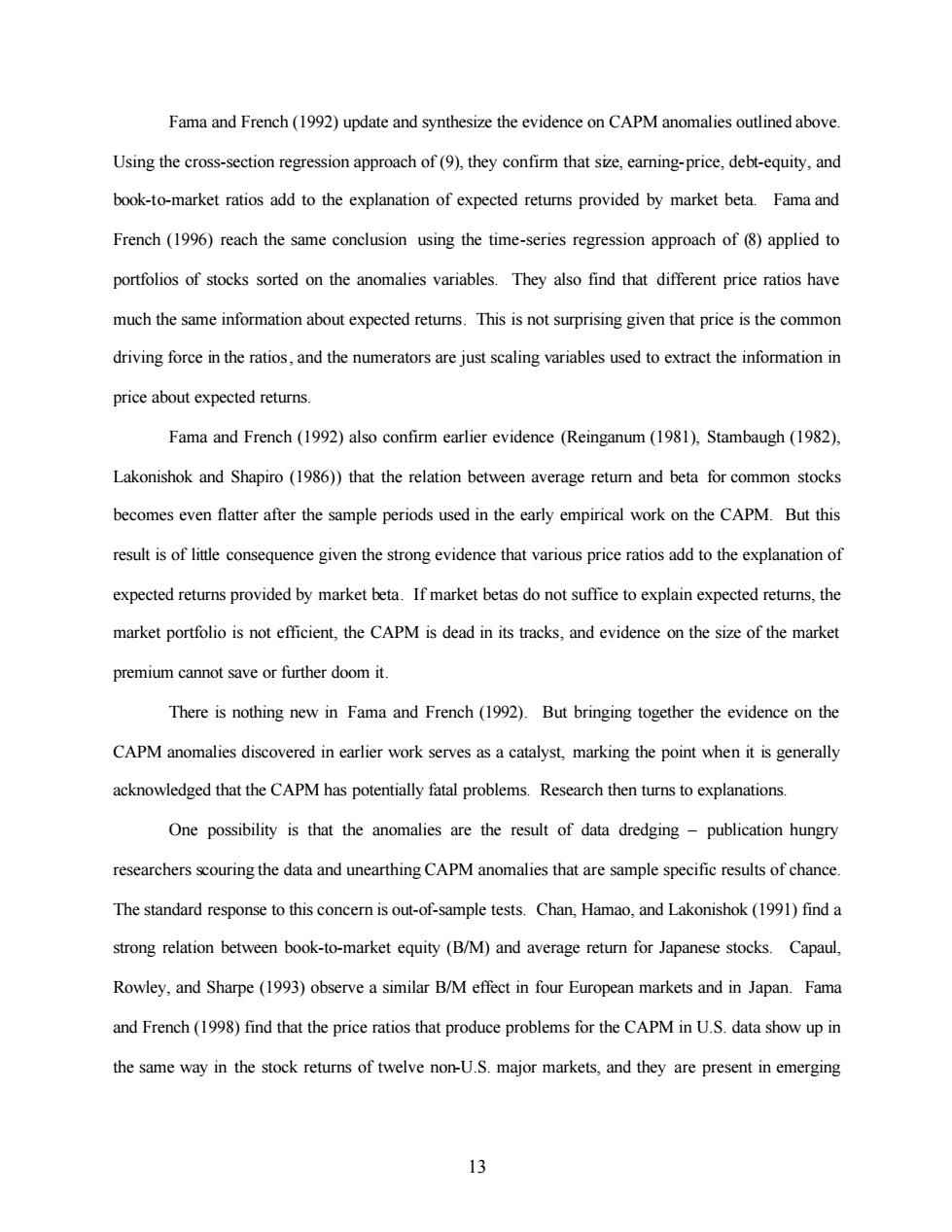正在加载图片...

Fama and French(1992)update and synthesize the evidence on CAPM anomalies outlined above. Using the cross-section regression approach of(9),they confirm that sie,earning-price,debt-equity,and book-to-market ratios add to the explanation of expected returns provided by market beta.Fama and French(1996)reach the same conclusion using the time-series regression approach of(8)applied to portfolios of stocks sorted on the anomalies variables.They also find that different price ratios have much the same information about expected returns.This is not surprising given that price is the common driving force in the ratios,and the numerators are just scaling variables used to extract the information in price about expected returns. Fama and French(1992)also confirm earlier evidence (Reinganum(1981),Stambaugh(1982), Lakonishok and Shapiro (1986))that the relation between average return and beta for common stocks becomes even flatter after the sample periods used in the early empirical work on the CAPM.But this result is of little consequence given the strong evidence that various price ratios add to the explanation of expected returns provided by market beta.If market betas do not suffice to explain expected returns,the market portfolio is not efficient,the CAPM is dead in its tracks,and evidence on the size of the market premium cannot save or further doom it. There is nothing new in Fama and French(1992).But bringing together the evidence on the CAPM anomalies discovered in earlier work serves as a catalyst,marking the point when it is generally acknowledged that the CAPM has potentially fatal problems.Research then turns to explanations. One possibility is that the anomalies are the result of data dredging-publication hungry researchers scouring the data and unearthing CAPM anomalies that are sample specific results of chance. The standard response to this concern is out-of-sample tests.Chan,Hamao,and Lakonishok(1991)find a strong relation between book-to-market equity (B/M)and average return for Japanese stocks.Capaul, Rowley,and Sharpe(1993)observe a similar B/M effect in four European markets and in Japan.Fama and French(1998)find that the price ratios that produce problems for the CAPM in U.S.data show up in the same way in the stock returns of twelve non-U.S.major markets,and they are present in emerging 1313 Fama and French (1992) update and synthesize the evidence on CAPM anomalies outlined above. Using the cross-section regression approach of (9), they confirm that size, earning-price, debt-equity, and book-to-market ratios add to the explanation of expected returns provided by market beta. Fama and French (1996) reach the same conclusion using the time-series regression approach of (8) applied to portfolios of stocks sorted on the anomalies variables. They also find that different price ratios have much the same information about expected returns. This is not surprising given that price is the common driving force in the ratios, and the numerators are just scaling variables used to extract the information in price about expected returns. Fama and French (1992) also confirm earlier evidence (Reinganum (1981), Stambaugh (1982), Lakonishok and Shapiro (1986)) that the relation between average return and beta for common stocks becomes even flatter after the sample periods used in the early empirical work on the CAPM. But this result is of little consequence given the strong evidence that various price ratios add to the explanation of expected returns provided by market beta. If market betas do not suffice to explain expected returns, the market portfolio is not efficient, the CAPM is dead in its tracks, and evidence on the size of the market premium cannot save or further doom it. There is nothing new in Fama and French (1992). But bringing together the evidence on the CAPM anomalies discovered in earlier work serves as a catalyst, marking the point when it is generally acknowledged that the CAPM has potentially fatal problems. Research then turns to explanations. One possibility is that the anomalies are the result of data dredging – publication hungry researchers scouring the data and unearthing CAPM anomalies that are sample specific results of chance. The standard response to this concern is out-of-sample tests. Chan, Hamao, and Lakonishok (1991) find a strong relation between book-to-market equity (B/M) and average return for Japanese stocks. Capaul, Rowley, and Sharpe (1993) observe a similar B/M effect in four European markets and in Japan. Fama and French (1998) find that the price ratios that produce problems for the CAPM in U.S. data show up in the same way in the stock returns of twelve non-U.S. major markets, and they are present in emerging